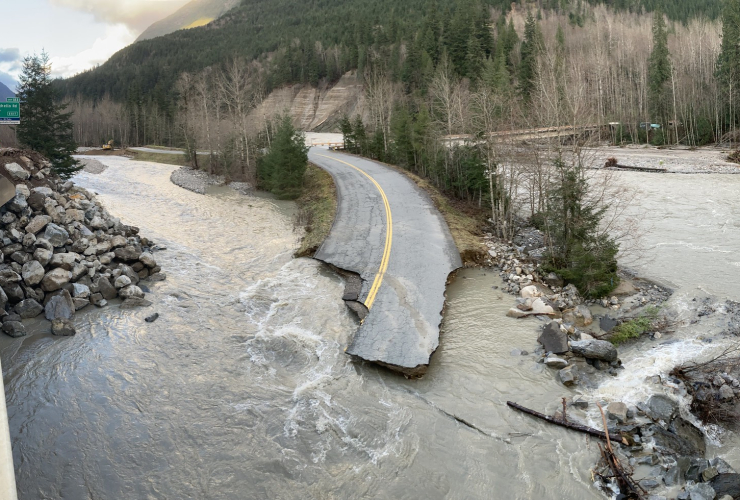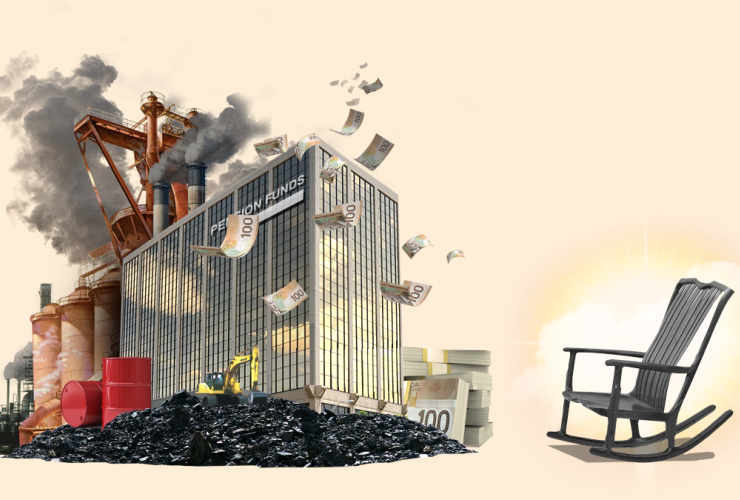When it comes to energy policy, the news cycle right now can be confusing. In the course of a few weeks in March and April, there were a series of what felt like conflicting announcements.
In late March, Ottawa released its Emissions Reduction Plan, which included a trajectory to drive down emissions generated by oil and gas production in Canada. A week later, the IPCC released its latest report on the deepening climate emergency, imploring countries to rapidly and substantially reduce their use of fossil fuels.
Meanwhile — also in March — Natural Resources Minister Jonathan Wilkinson announced that Canada could increase oil and gas exports this year by up to 300,000 barrels per day to help buttress the global supply amidst Russian aggression in Ukraine. Shortly afterwards, the federal government approved a new offshore oil project in Newfoundland and Labrador.
How do we make sense of these developments when they seem to undercut each other on such a regular basis?
A good way of thinking about it is to consider medium- and long-term needs versus short-term demands.
Long-term climate action not at odds with energy security
The Russian invasion of Ukraine has prompted the world to search for secure and immediately available energy supplies. In the short term, if European countries are to apply deeper sanctions on Russia and ultimately stop buying its product, they need to find new suppliers of oil and gas — which is why EU leaders continue to pressure the OPEC nations to increase production.
But in the longer term, Europe’s response to events in Ukraine has been to stick to decarbonization efforts and accelerate investment in renewables. For example, it is committed to its Fit for 55 plan to reduce natural gas use 30 per cent by 2030 and is considering accelerating investment in wind and solar power in the next few years to reduce dependence on Russian fossil fuels. Plans to institute a Border Carbon Adjustment Mechanism — which will impose new taxes on imports from countries that are less ambitious than the EU on climate — forge ahead.
Put simply: the answer to the energy security question can look very different if you take an immediate or longer-term view. The key is to make sure the solutions we choose to meet our short-term needs do not jeopardize our longer-term climate imperatives. In the face of a climate emergency, our approach to energy security today must be consistent with a responsible approach to climate change and the need to reduce our carbon emissions.
Change has begun
Despite the volatility of global oil markets in the last few months, the current pace at which governments are introducing climate policies — and associated changes to the way we produce and consume energy — is not far off from the International Energy Agency’s Announced Pledges Scenario, which forecasts a plateau and decline in demand for oil in this decade. Oil majors BP and Equinor forecast a peak in oil demand before 2030, even without more ambitious climate action.
Take sales of electric vehicles for example, which increased globally and in Canada during the pandemic and continue to outpace International Energy Agency projections of what is needed to reach a net-zero transportation sector by 2050.
As consumers continue to make the switch to EVs, their need for oil will further decrease (and will be replaced by increased demand for electricity, which is why the Pembina Institute is working with the federal government on moving Canada’s grid to net-zero). According to data from the International Energy Agency, EVs represented just over two per cent of vehicle sales globally in 2019; by the end of 2021, market share had risen to nine per cent. Early figures from 2022 indicate that this trend continues, despite supply chain challenges.
Figure 1: Global market share of EVs over time.
In light of this pace of change, it is important to consider what federal policies, such as the carbon price, are designed to do. Earlier this month, Alberta Environment Minister Jason Nixon wrote about the federal government’s Emissions Reduction Plan, which he wrongly asserted included policies to cut production in the oil and gas sector that would “destroy Alberta’s economy.” Rather, policies aimed at decarbonization will shield the economy from global economic and political trends that are already having and will continue to have, significant impacts on Canadian industry.
For example, the most effective solutions to Europe’s energy security needs right now are projects that can scale up quickly to fill the supply vacuum, but can also pay back capital costs quickly (and therefore don’t lock investors into long-term, emissions-intensive fossil fuel projects that are at odds with decarbonization policies). Most sources of Canadian oil do not fit the bill; oilsands and offshore projects, as well as pipelines and export terminals, take time to scale up and must operate for decades to provide good investment returns. The likelihood of these assets becoming stranded (when they can’t adhere to changing climate policies during their decades in operation) increases the longer we delay deep decarbonization strategies. The Bank of Canada notes that clear, stable and ambitious climate policy is the best way to mitigate these financial risks.
Invest now or pay later
There are costs, both economic and social, associated with reforming global energy systems. Canada’s Emissions Reduction Plan pledges "new investments" of about $9 billion to stimulate innovative climate solutions, which is a start (though not nearly enough) to get to net-zero. But the cost of doing nothing — of failing to mitigate climate change below the international 1.5 C target — is far higher. Estimates put the price of not meeting Paris Agreement targets between US$149 trillion and $792 trillion globally by 2100. And the bills are piling up now: the Canadian Climate Institute estimates that costs related to weather disasters have risen by 1,250 per cent since the 1980s.
Nobody said the move to cleaner sources of energy would be straightforward, and the confusion of the last few weeks reflects the moment we are in. As we struggle to balance long-term climate needs with immediate shocks to our economy, we must keep our eyes on 2030 and 2050 and recognize that the consumers of oil have even more reasons now to eliminate its use.
In the years ahead, true energy, economic and climate security will come from increasing our share of renewable energies and decarbonizing our industrial processes to the greatest extent possible.
Janetta McKenzie is a senior analyst with the oil and gas team at the Pembina Institute. She works on energy policy development, natural gas certification, and industrial decarbonization in Canada. Prior to joining the institute, McKenzie completed a PhD at the University of Waterloo, analyzing the efficacy of pipeline regulation in Canada and the U.S. She has contributed to a variety of research projects on international climate governance.
McKenzie: "The key is to make
McKenzie: "The key is to make sure the solutions we choose to meet our short-term needs do not jeopardize our longer-term climate imperatives."
Unlike most ENGOs and the 400+ scientists and academics who signed an open letter in January advising against federal support for carbon capture (CCS) in the O&G sector, the largely corporate-sponsored Pembina Institute has long supported both carbon capture in Canada's O&G sector and massive public subsidies to fund it.
"Are Canada's carbon capture plans a 'pipe dream'?' (National Observer, 20-Jan-22)
"Leading climate scientists and academics are calling on the federal government to abandon a proposed tax credit that gives big polluters a break for investing in carbon capture technology.
"The experts say the planned carbon capture utilization and storage (CCUS) tax credit will lock in fossil fuel use and risk ruining Canada's chances of meeting emission reduction goals.
https://www.nationalobserver.com/2022/01/20/news/are-canadas-carbon-capt...
"Environmental think tank the Pembina Institute says capturing and storing CO2 from oilsands facilities, refineries and gas plants could reduce Canada's emissions by 15 Mt by 2030.
"'There is a significant role for carbon capture in decarbonizing the O&G industry,' said Simon Dyer, the Pembina Institute's deputy executive director. 'We don’t know any details about the investment tax credit yet. But we don’t oppose those sorts of investments to sort of kickstart that industry.'"
"Carbon capture tax credit a divisive topic; opinions split over potential benefits" (Canadian Press, March 30, 2022)
https://www.thestar.com/business/2022/03/30/carbon-capture-tax-credit-a-...
"Some environmental groups lambasted the feds for the new measure, but Jan Gorski of the Pembina Institute said the 50% level was appropriate. Combined with other federal policies, such as a national price on carbon and the incoming clean fuel standard, it will provide an incentive for companies to invest."
"Varcoe: Federal incentive for carbon capture puts ball back in Alberta's court" (Apr 08, 2022)
https://calgaryherald.com/opinion/columnists/varcoe-federal-incentive-fo...
This despite acknowledging that in the oilsands sector "most CO2 is emitted in low concentration streams, and the efforts to capture it will be challenging and expensive."
"Public Policy Forum urges government to help finance oil and gas emission reductions" (March 17, 2022)
https://www.corporateknights.com/energy/public-policy-forum-urges-govern...
Pembina has long promoted
Pembina has long promoted oxymoronic "responsible" oilsands development and collaborated with industry on failed climate plans.
"Meet the green group that the oilpatch can work with" (Financial Post, April 21, 2016)
https://financialpost.com/commodities/energy/meet-the-only-green-group-t...
A former director of the Pembina Institute — a self-styled "pragmatic" environmentalist, i.e. industry collaborator — pens op-eds in the Globe and Mail making the oilsands industry's case for new export pipelines.
"Balancing climate and energy policy, the Trans Mountain pipeline is the right decision for Canada"
https://www.theglobeandmail.com/opinion/article-balancing-climate-and-en...
The same "pragmatist" makes the oilsands industry's case for carbon capture and storage:
"Rejecting carbon capture risks increasing emissions. Here's why" (National Observer, January 25th 2022)
https://www.nationalobserver.com/2022/01/25/opinion/rejecting-carbon-cap...
If the above does not help to explain Pembina's muted criticism of Canada's fossil-fuel expansion agenda and confusing ambivalence on climate policy, it may provide useful context.
Article: "… Shortly
Article: "… Shortly afterwards, the federal government approved a new offshore oil project in Newfoundland and Labrador. How do we make sense of these developments when they seem to undercut each other on such a regular basis? A good way of thinking about it is to consider medium- and long-term needs versus short-term demands."
Of course, offshore oil projects are not based on "short-term demands". You don't build offshore oil projects and pipelines to run them for five or ten years. Large-scale fossil fuel infrastructure must operate for decades to recoup their costs. Hence, fossil fuel "lock-in".
This conclusion is buried in the article: "Most sources of Canadian oil do not fit the bill; oilsands and offshore projects, as well as pipelines and export terminals, take time to scale up and must operate for decades to provide good investment returns."
Article: "the current pace at which governments are introducing climate policies — and associated changes to the way we produce and consume energy — is not far off from the International Energy Agency’s Announced Pledges Scenario"
The IEA's Announced Pledges Scenario does not get the world to net zero by 2050 or limit warming below 2.0 C by 2100.
IEA: "How do the scenarios relate to the pursuit of a 1.5°C outcome?"
https://www.iea.org/reports/world-energy-model/understanding-weo-scenari...
How to reconcile the Announced Pledges Scenario (much less the Net Zero Emissions by 2050 Scenario (NZE) and the Sustainable Development Scenario (SDS)) with Canada's fossil fuel expansion agenda?
The article does not state the obvious: Canada is headed for failure.
"In late March, Ottawa
"In late March, Ottawa released its Emissions Reduction Plan, which included a trajectory to drive down emissions generated by oil and gas production in Canada."
It's not an emissions reduction plan. It's a plan to make people believe they are serious about reducing emissions, using all kinds of sleight-of-hand calculations and, male bovine excrement, because they believe getting re-elected depends on voters. But they also know that no one gets elected without a mighty election war-chest full, and that their backs get scratched when they scratch the backs of the carbon-producers, who, after all, have deep pockets and are more than willing to champion the election of parties who hew to their favorite sleight-of-hand policy preferences -- not to mention capable of trashing the political careers of those who will buck them off before the bell rings. They've ridden the same bulls for decades. They care nothing for truth, or for nature. Just their pocketbooks.
"A good way of thinking about it is to consider medium- and long-term needs versus short-term demands."
Good, perhaps, if one is intent on wool-gathering for the sake of getting enough of the stuff to pull over electors' eyes.
The problem is NOT just "getting to zero;" it's a matter of how much goes into the air *before* getting to zero. I blame the education system: no one understands math any more. It's not the endpoint of the curve that counts, it's the area under the curve. That's elementary calculus, and understanding very basic geometry. Draw a graph, you don't need numbers. Choose a high point (representing annual carbon emission) on the y-axis, that's the up-and-down line; then choose an end-point (representing the "net-zero" year) along the x-axis, the horizontal line.
For illustration of the concept, you don't even need to take into account that we plan to actually *increase* emissions for several years yet. Just draw three lines, as follow, in different colors, to make clear what's going on. Next draw a straight line joining those two chosen points. Then draw a quarter-circle, with the same endpoints. Then mark a rough halfway point, on the bottom, horizontal line; and draw a line from the same starting point as the other two, but this time, angle your new line upward till it gets to roughly that halfway point across the page towrds the endpoint, then for the second half of that line, join the new high point to the same-ol' endpoint.
Those lines all get to zero, by the same target date. Nature has some concern with zero, yes. But nature doesn't concern herself with the sleight-of-hand tricks one uses getting there; nature counts the total amount of carbon emissions dumped into the atmosphere. And that, my friends, is the total area "under the curve," i.e., the area of the triangle, the area of the quarter circle, and the area of that third piece. Tell any four year-old they can have a piece of cake the same size and shape as is made by the line straight up-and-down, the horizontal line, and one of the colored lines. I think everyone knows even a four-year-old will instinctively choose the largest piece, without understanding any of the niceties of math at all.
So do the carbon producers, and they know their tummies (pocketbooks) get fuller with bigger pieces of cake than with smaller ones. Donhhh.
The carbon-producer apologists, like the author, take up the line of BS fed to the politicians, who either are too stupid (no understanding of math) to know the difference, or too immoral to care about being honest about the planetary destruction they cause by choosing the simple arithmetic of their bank accounts over the more complex calculus of truth and nature (easy enough to understand intuitively by a four-year-old choosing cake).
"Take sales of electric vehicles for example, which increased globally and in Canada during the pandemic and continue to outpace International Energy Agency projections of what is needed to reach a net-zero transportation sector by 2050."
The point is not increasing sales of electric vehicles, but retiring the gasoline and gas burners. It'd be better if no one ever bought a car again, and even moreso we all *could* walk everywhere. In Canada during the pandemic, the price of used cars grew astronomically, because no one was getting rid of their "gas cars" and people who hadn't owned vehicles were clamoring to own whatever was lowest priced. Because no other transport was Covid safe: a condition that persists right up to today.
Not to mention that most of the population has no choice but to use what they've got, or what's cheapest. That, my friends, is part of the cost of poverty to all of us. Not to mention the cost of ever-increasing wealth of the wealthy, who go where the money is, and that's not in line with getting as quickly as possible to net zero.
The Pembina Institute haslong time been a lackey of the oil-and-gas industry. It might have changed, but I sure didn't get the announcement, and apparently neither has the author.






Comments